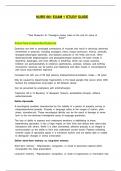TEST BANK
Luxury Fashion Marketing and Branding,
A Strategic Approach, 1st Edition by
Alice Dallabona
Complete Chapters Test Bank
are included (Ch 1 to 11)
** Immediate Download
** Swift Response
** All Chapters included
,Table of Contents are given below
1. What is Luxury
2. What is a Luxury Fashion Brand
3. Strategic Challenges for Luxury Fashion Brands
4. Luxury Fashion Consumer Behaviour
5. Luxury Fashion Retail
6. Brand Identity for Luxury Fashion Marketing
Communications
7. Luxury Fashion Promotion and Advertising
8. Digital and Social Media Marketing for Luxury
Fashion
9. Luxury Fashion Marketing and Emerging
Technologies
10. Diversity, Inclusivity and Cultural Sensitivity
11. Sustainability and Ethical Issues in Luxury Fashion
, CHAPTER 1
WHAT IS LUXURY
Essay questions
1. Conceptualisations of luxury are based on a number of salient traits, examine what
are the characterising elements of luxury and discuss their relationship with notions
of luxury fashion. Consider both the positive and negative narratives associated with
ideas of luxury, also including historical perspectives and through examples.
- Salient traits: opulence, pleasure, desirability, superfluity (both
positive and negative), inappropriateness (negative).
- criticism about inappropriateness of luxury shaped in the Western
World by Greek philosophy, Christianity but also philosophers like
Rousseau.
(Moderate; 1. 3 Defining luxury)
2. Luxury goods, including those associated with luxury fashion brands, need to
possess a series of characteristics to be deemed as such. Examine those salient traits
and discuss, where appropriate, their problematic role in the contemporary luxury
fashion industry.
- Characterising traits: rarity, scarcity and restriction, high quality, good
design and aesthetic value, craftsmanship and uniqueness, exclusivity
and high price.
- Problematic issues in the contemporary luxury fashion industry:
rarity, scarcity and restriction only of limited goods, for other goods
that is achieved through complexity of acquisition, communication and
marketing.
(Moderate; 1. 4 Characteristics of luxury goods)
3. For a long time, high price has been seen as the most obvious characterising trait of
luxury fashion goods. However, many luxury fashion brands have expanded
consistently into the lower market segment and associated their names to cheaper
goods. Examine this phenomenon and identify what enables luxury fashion brands to
pursue this strategy. Discuss the different levels of luxury now present within the
industry by examining at least two models. Lastly, consider how, and why, luxury
fashion labels are now adopting brand elevation strategies, also providing examples.
- brand extension into the lower brand extension made possible by the
power of brands, they possess symbolic magic that wraps any good in
aura of desirability and luxury. Taking place since the 1980s, to
, capitalise on rise of the middle classes and to expand in areas where
margins are higher.
- conceptualisations of different levels of luxury: Okonkwo (2007),
Alleres (1990). Silverstein and Fiske (2003 and 2005)
- brand elevation aims to support narratives of prestige and exclusivity.
Pursued for example by focusing on more affluent clientele or by
enforcing limits of purchase. Example: Armani.
(Moderate; 1. 5 Different levels of luxury)
Open questions
4. Conceptualisations of luxury are based on a number of salient traits, and many of
them are considered positive. Discuss the desirable characterising elements of luxury
also by using examples.
- Salient traits: opulence, sensory appeal, pleasure, enjoyment,
desirability, superfluity (both positive and negative).
(Moderate; 1. 3 Defining luxury)
5. Conceptualisations of luxury are based on a number of salient traits, but not all of
them are actually positive. Examine the negative characterising traits of luxury and
discuss, in a historical perspective, the debates in the Westerns World concerning this
dimension.
- Salient traits: superfluity (both positive and negative),
inappropriateness (negative).
- criticism about inappropriateness of luxury shaped in the
Western World by Greek philosophy, Christianity but also
philosophers like Rousseau.
(Moderate; 1. 3 Defining luxury)
6. Rarity, scarcity and restriction have been considered in literature as characterising
traits of luxury goods. However, in the contemporary luxury fashion industry, those
traits can be problematic. Discuss also through examples.
- Rarity, scarcity and restriction only of limited goods, for other
goods that is achieved through complexity of acquisition,
communication and marketing.
(Moderate; 1. 4 Characteristics of luxury goods)





